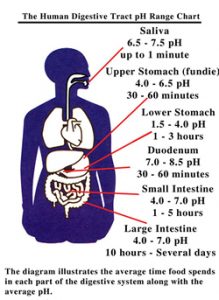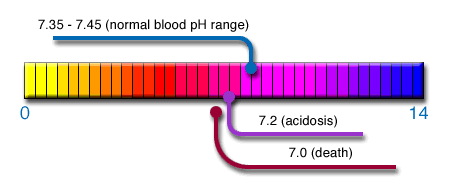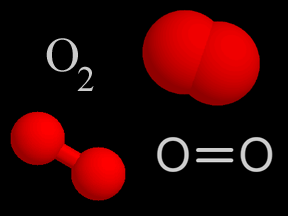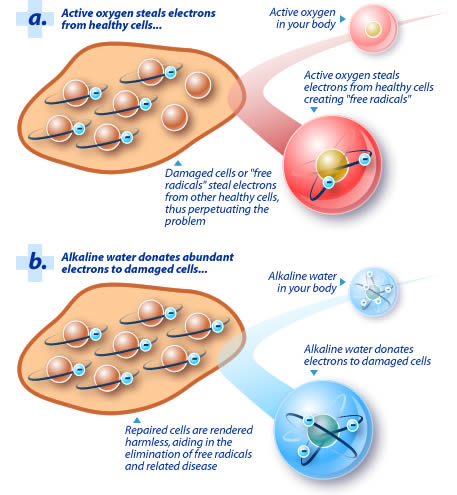pH: What does it mean? pH is the abbreviation for potential hydrogen. The pH of any solution is the measure of its hydrogen-ion concentration. The higher the pH reading, the more alkaline and oxygen rich the fluid is. The lower the pH reading, the more acidic and oxygen deprived the fluid is. The pH range is from 0 to 14, with 7.0 being neutral. Anything above 7.0 is alkaline, anything below 7.0 is considered acidic.

Human blood stays in a very narrow pH range right around ( 7.35 – 7.45 ). Below or above this range means symptoms and disease. If blood pH moves to much below 6.8 or above 7.8, cells stop functioning and the patient dies. The ideal pH for blood is 7.4
A healthy blood pH without cancer has acid + alkaline balance almost equal. Actually a healthy body is slightly alkaline measuring approximately 7.4. This ideal blood 7.4 pH measurement means it is just slightly more alkaline than acid.

The pH in the human digestive tract varies greatly (see Human Digestive Tract pH Range Chart on the left side). The pH of saliva is usually between 6.5 – 7.5. After we chew and swallow food it then enters the fundic or upper portion of the stomach which has a pH between 4.0 – 6.5. This is where “predigestion” occurs while the lower portion of the stomach is secreting hydrochloric acid (HCI) and pepsin until it reaches a pH between 1.5 – 4.0. After the food mixes with these juices it then enters the duodenum (small intestine) where the pH changes to 7.0 – 8.5. This is where 90% of the absorption of nutrients is taken in by the body while the waste products are passed out through the colon (pH 4.0 – 7.0).
If you have a health problem, most likely you are acidic. Research shows that unless the body’s pH level is slightly alkaline, the body cannot heal itself. So, no matter what type of modality you choose to use to take care of your health problem, it won’t be as effective until the pH level is up. If your body’s pH is not balanced, you cannot effectively assimilate vitamins, minerals and food supplements. Your body pH affects everything.
Total healing of chronic illness only takes place when and if the blood is restored to a normal, slightly alkaline pH.
An Imbalance In the body’s pH may lead to serious health concerns, including:
Hormone concerns
Cardiovascular weakness
Weight gain/loss
Bladder and kidney concerns.
Immune deficiency
Acceleration of free radical damage.
Structural system weakness, including brittle bones, hip fractures and joint discomfort
Stressed liver function
Low energy
Slow digestion and elimination
Yeast/fungal overgrowth.
Tumor growth
The body has to have a balanced pH like most living things on earth or it does not function correctly. The alkaline level is very important because research has already proven that disease cannot survive in an alkaline state and yet they thrive in an acidic environment.

The truth is everyone has different nutrient requirements, but we all share one thing in common – we need to have alkaline blood to stay healthy.An acidic balance will: decrease the body’s ability to absorb minerals and other nutrients, decrease the energy production in the cells, decrease it’s ability to repair damaged cells, decrease it’s ability to detoxify heavy metals, make tumor cells thrive, and make it more susceptible to fatigue and illness.

An acidic pH can occur from, an acid forming diet, emotional stress, toxic overload, and/or immune reactions or any process that deprives the cells of oxygen and other nutrients. The body will try to compensate for acidic pH by using alkaline minerals. If the diet does not contain enough minerals to compensate, a build up of acids in the cells will occur.
There are two factors that are ALWAYS present with cancer no matter what else may be present. Those two factors are Acid pH and Lack of Oxygen. Can we manipulate those two factors that always have to be present for cancer to develop and by doing so may help reverse the cancer? If so, we need to learn how to manipulate those two factors.
Cancer needs an acid and low oxygen environment to survive and flourish within. Terminal cancer patients are around 1000 times more acidic than normal healthy people. The vast majority of terminal cancer patients possess a very low body pH. Why?
In the absence of oxygen, glucose undergoes fermentation to lactic acid. This causes the pH of the cell to drop from between 7.3 to 7.2 down to 7 and later to 6.5 in more advanced stages of cancer and in metastases the pH drops to 6.0 and even 5.7 or lower. Our bodies simply can not fight disease if our body pH is not properly balanced.

Shown here are four representations chemists use for molecular oxygen. In colored molecular models, oxygen is traditionally shown in red.
The normal human cell has a lot of molecular oxygen and a slightly alkaline pH. The cancer cell has an acid pH and lack of oxygen. Cancer cells cannot survive in an oxygen rich environment. At a pH slightly above 7.4 cancer cells become dormant and at pH 8.5 cancer cells will die while healthy cells will live. Again, the higher the pH reading, the more alkaline and oxygen rich the fluid is. Cancer and all diseases hate oxygen / pH balance. The proper alkalinity pH of the blood ( 7.35 – 7.45 ) is critical for the overall health of the body. In other words… alkalize or die.

Remember that the pH number is an exponent number of 10; therefore, a small difference in pH translates to a big difference in the number of oxygen or OH-ions. A difference of 1 in a pH value means ten times the difference in the number of OH-ions, a difference of 2 means one hundred times the difference in the number of OH-ions. In other words, blood with a pH value of 7.45 contains 64.9% more oxygen than blood with a pH value of 7.30.







 Malaysia
Malaysia